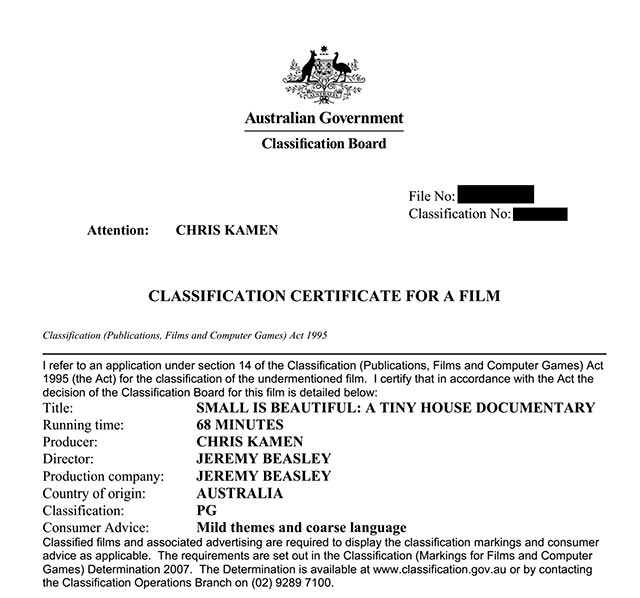
There’s been a few moments when it’s felt?real that we’ve made a film. Receiving the completed masters from the Post House and this. Classification.
We had to have our film classified as part of the requirements for submission to iTunes Australia and to show it in cinemas via Tugg.
What does it take to get a movie classified in Australia?
Basically,?it costs about $700 and takes about a month.
Step 1: First, check whether you actually need to get your movie classified by the Australian Classification Board. They have?published a guide to all the different exemptions for random things?here.?Generally, the idea is that you need to get classification for anything that you or I would conceive as a film/movie and will be?sold it?or screened?it?to lots of people. If you plan to sell tickets and screen it in lots of cinemas then it needs to be?classified, but if it’s a once off screening in your local town hall you could probably get away with it. (The guys at Tugg definitely want it to be classified). You’ll also need classification?to be able to sell your movie on a VOD platform?like iTunes.?But there are also lots of exceptions, e.g. a common one is that film festivals get blanket exemptions.
Also check whether you could apply for a fee wavier, so that your classification is free. There are specific types of content that are exempt from fees:?special interest material, limited distribution, a documentary or record of an event, or if it’s some sort of cultural activity like a recording of a dance or sporting event.
Step 2:?Create an account with the Classification Board. This is an account you can use ongoing, so best to register in your production company’s business name, or just as yourself, so that you can register many?films over time.
Step 3:?Submit an application for classification. They have a handy guide?page to walk you through the whole process, which is different depending on what you are getting classified.
For a film, you’ll need to post them?in hardcopy:
- A?completed application form (there are different forms?depending on the?type of application, eg, whether it’s for screening in cinemas or whether you’re just selling DVDs or putting it on iTunes.)?You need to tell them what naughty or nasty things are in your film. We had to ‘fess up that there were three swear words in our film (so Jeremy got all worried it would get rated R! Agh!)
- A?DVD of your finished movie. (Bless them, but they haven’t quite arrived in the 21st century so you can’t upload your?movie or send them a digital file, it has to be on VHS or DVD).
- Money! They take credit cards. It cost $730 for us, but the fee can change depending on the type of application and whether you’re in a rush. Ie, 20 days is the standard turnaround, but if you pay another $420 then that will allow them to buy the office more?coffee and red cordial to get it done?in a week.
- A completed Classifiable Time Worksheet. This tells them what you’re actually getting classified, duration, etc. You can get multiple films classified at once.
- A written synopsis ? this needs to summarise the plot of the film from start to finish.
Step 4:?Play the waiting game. Once they receive and check your paperwork is all in order, they’ll schedule your movie to be reviewed by a reviewer (I read somewhere?the reviewers are specifically chosen as ‘average’?people with ‘average’ tastes, chosen from across the community ? kind of like a jury in court). It took 28 days for our film from when we posted our application to them and when we got our classification. During this time you get daily email updates of what’s happening, along with?an ETA, which is nice.
Step 5: Eventually you get an email saying your film is classified, with a PDF certificate attached. Yay! (But you might get a different kind of email if your movie contains filthy horrible disgusting?things and they refuse to classify your movie.)
Step 6: Once you know what your film has been classified as, you?have to download classification ‘markings’ and put them on all your advertising material like posters and movie trailers, along with your physical products (like DVDs and BluRays).
In our case, we got classified as PG with the extra note of ‘Mild themes and coarse language’, so this is the marker that we have to put on things:

And that’s how to?get your film classified in Australia.
– Chris